While shooting an architectural assignment.
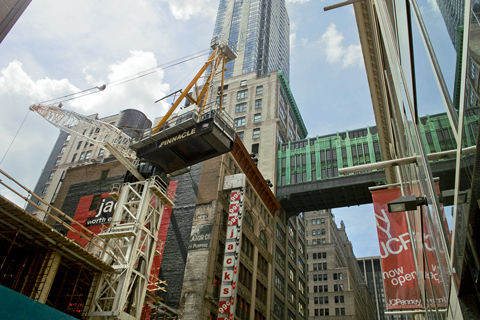
Near Penn Station — © Brian Rose
On my way to Trenton–pictures to come.
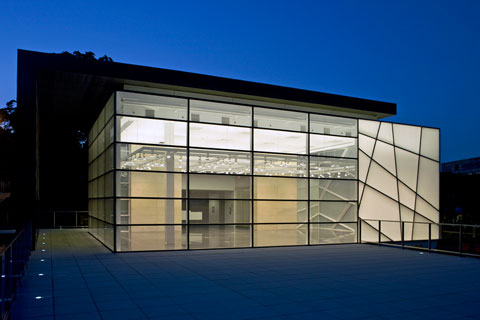
Queensborough Community College, Holocaust Research Center — © Brian Rose
Assignment work: In the past few weeks I’ve photographed an apartment building in Brooklyn, a residential interior in the same building, an NYU dormitory, an office in the Empire State Building, a residence for mentally disabled in the Bronx, a holocaust research center in Queens, and a series of photographs of the Hudson Square area of Manhattan. Next on deck, the Museum of the State of New Jersey, and a Columbia University academic building.
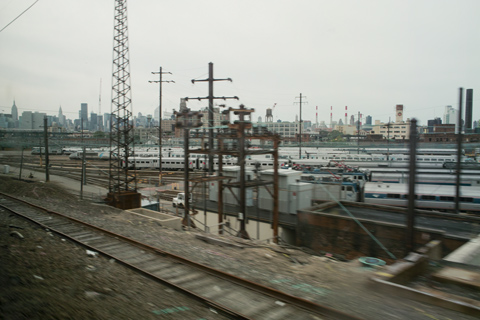
Sunnyside Yards, Queens — © Brian Rose
I’ve been busy lately. A number of assignments after a barren winter and spring. I get an email from the publisher of the Lost Border–this has been a particularly brutal year for the bookselling and publishing industries…
Basically they are telling me that my book is being remaindered–conveniently timed to the 20th anniversary of the fall of the Berlin Wall. Brilliant marketing strategy. Give the books away at the moment when interest in the subject will be at its peak.
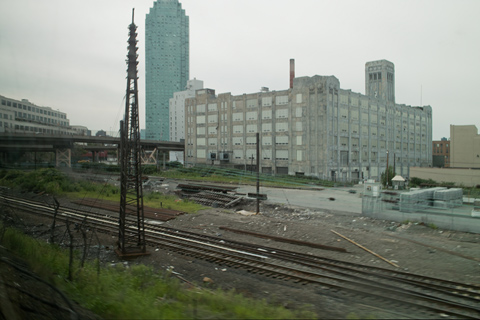
Long Island City, Queens — © Brian Rose
Speeding through the city on a moving train. I am pleased, however, to contribute some of my Iron Curtain photographs to a literary project timed to the 20th anniversary of the end of the Wall, a book titled The Wall in my Head.
The Wall in My Head combines work from the generation of writers and artists who witnessed the fall of the Iron Curtain firsthand with the impressions and reflections of those who grew up in its wake and whose work, childhoods, and memories are all colored by the long shadow that it cast. The Wall in My Head provides a unique view into the change, optimism, and confusion that came with 1989 and examines how each of these has weathered the twenty years since that fateful year.
More on this later. Here is the book’s website.
More photographs of Hudson Square, sometimes known as the Printing District, on the west side of Manhattan bordered by the West Village, Soho, and Tribeca. These are digital images made alongside similar ones on 4×5 film.
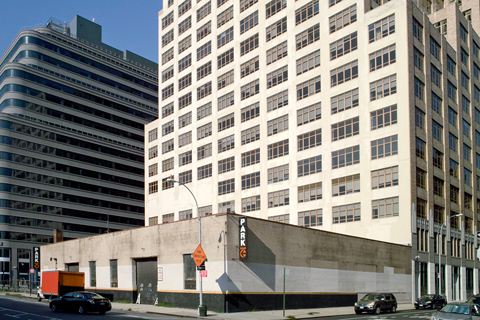
Greenwich Street — © Brian Rose
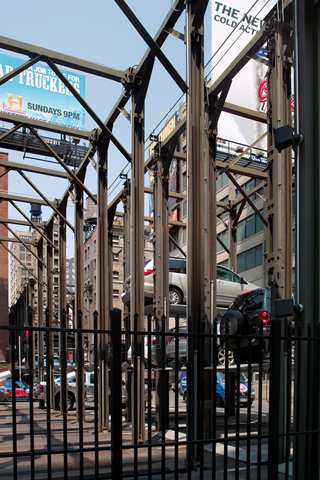
Dominick Street — © Brian Rose
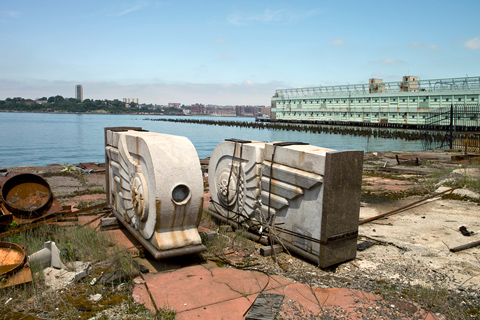
West Side Highway artifacts — © Brian Rose
Stan B. in his comment to the last post mentions the “post apocalyptic piece of concrete” that stood abandoned for years on the west side of Manhattan. Inexplicably, despite all the fixing up and covering up of New York’s industrial past, a couple of art deco slabs of the West Side Highway can still be seen lying on a scruffy stretch of waterfront on the Hudson River.
Here are a couple of views from 1974 including a detail similar to the pieces in my photo above.
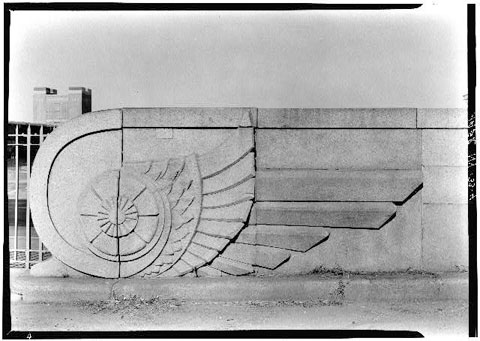
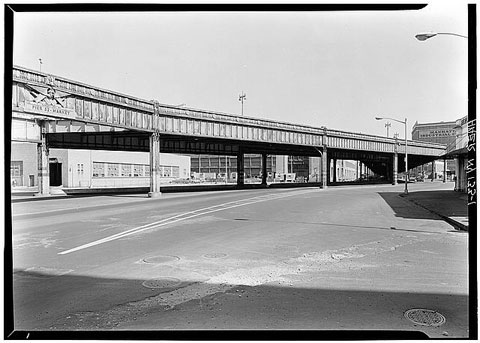
West Side Highway, 1974, Library of Congress photos
Below are a couple of oblique views of the highway taken around 1978 when I was a student. They’re on 35mm Kodachrome–one of the best films ever made, now discontinued. One was taken on the roadway looking down on the Calder sculpture at the World Trade Center. Destroyed on 9/11. In the other view of the reflected Twin Towers, you can just see some of the West Side Highway receding in the distance. It was desolate over there in those days.
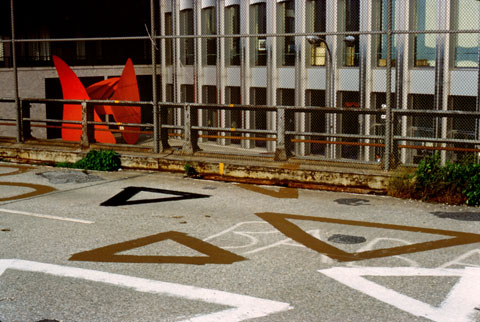
West Side Highway, World Trade Center, Bent Propeller by Alexander Calder, 1978
© Brian Rose
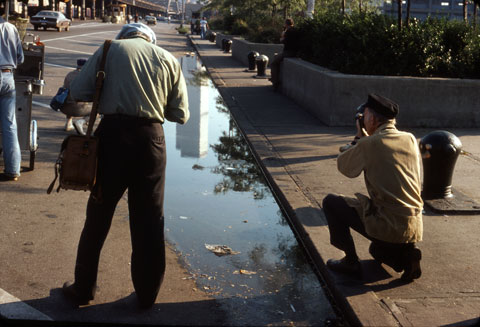
Along the Hudson River piers, 1978 — © Brian Rose
You can see more of my World Trade Center pictures here.
I was down on Canal the other day taking pictures of what is sometimes called the printing district, now updated to real estate friendly Hudson Square. Canal Street remains a tumultuous strip of cut-rate hardware, electronics, and jewelry shops, but some of its rough edges have been smoothed, as in the park above. It’s a pleasant, if over designed, replacement for a parking lot. Is there some way that New York parks could be designed with less predictable gentility?
A couple of blocks west there’s a more typical bit of Canal Street scruffiness. Here’s your inspiration for attempting an answer to the question above.
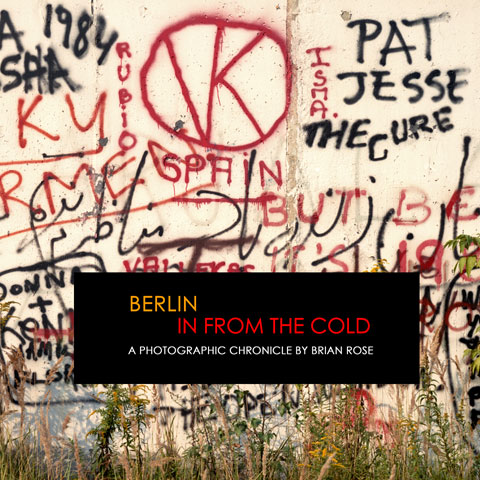
Berlin: In From the Cold (click for book website)
This November being the 20th anniversary of the opening of the Berlin Wall, I have put together a new book focused exclusively on my pictures of Berlin. My earlier book, The Lost Border, included many photographs of the Wall, but its focus was not primarily on Berlin, a city I have returned to repeatedly over the years. There is some overlap between the two books, but 2/3 of the images are new.
Before the Wall came down, I also made a number of images of East Berlin, which have never been seen. In from the Cold includes a dozen of these eerie images of a place seemingly frozen in time. After the Wall came down, I moved off of the border zone to some extent, photographing historical sites that resonated with the rest of my project.
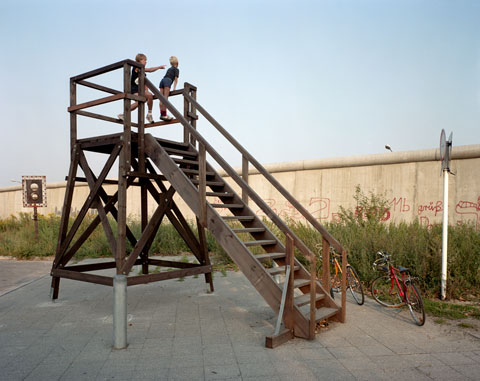
The Berlin Wall, 1985 — © Brian Rose
This is a Blurb book, which means it will be printed only on demand. Perhaps, there will be a commercial version of the book eventually, but not for now. The entire book is viewable on the Blurb website, which you are invited to browse through. It’s an expensive book, but if you choose to purchase it, you will own a unique piece of history, and a very limited production book worth collecting.
I have entered Berlin: In From the Cold in the Photography.Book.Now contest sponsored by Blurb. Please feel free to leave comments on the Blurb website, and click the vote button there to show your support.
Some people fall through the cracks–maybe lots of people fall through the cracks. It’s a fact that there are many extraordinary artists and musicians afoot who have not received the attention or accolades they deserve. I know a number of such people who remain neglected, but quite vital and alive, outside the gated community of the photo/art world.
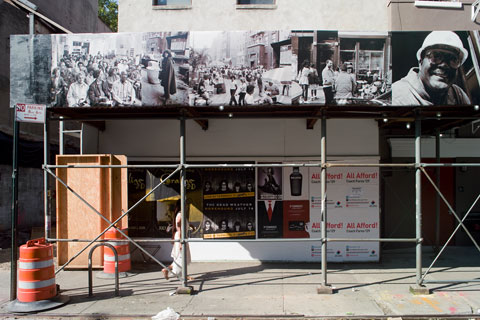
Alex Harsley exhibition on East 4th Street — © Brian Rose
No one is more hidden in plain sight than Alex Harsley, who maintains a small gallery on East 4th Street between Second and Third Avenues in the East Village, the block I lived on when I first came to New York–where I met my wife. I’ve written about Alex before–here and here.
As I walked down East 4th Street the other day, I came across a selection of his photographs affixed to the sidewalk shed of a building under construction. It turns out the installation is a small project of FAB, Fourth Arts Block, the umbrella organization representing the theaters and other cultural institutions on East 4th Street.
ArtUp, FAB’s public art program, is a rotating installation of artwork on the scaffolding bridge located on East 4th Street between Bowery & 2nd Avenue. With more than $16 million in renovations to the East 4th Street Cultural District underway, ArtUp seeks to transform the stodgy and dodgy look of construction sites and scaffolding into a streetside gallery.
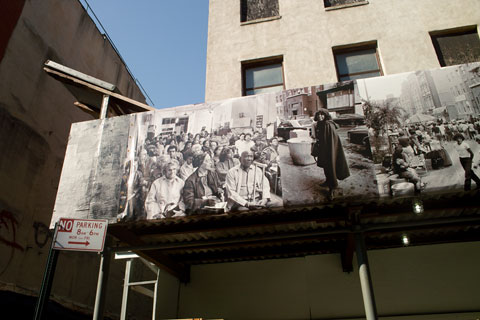
Cooper Square meeting and Ellen Stewart of La Mama theater
© Brian Rose
Harsley’s photographs on the scaffolding feature people and events associated with the arts and politics of this colorful, and sometimes contentious, piece of New York. Harsley has been documenting this area for decades. To the left is a picture of a community meeting, one of hundreds held over the years, by the Cooper Square Committee, an advocate for affordable housing. To the right of that is Ellen Stewart, the founder and director of La Mama theater, one of the most important creative incubators in the city.
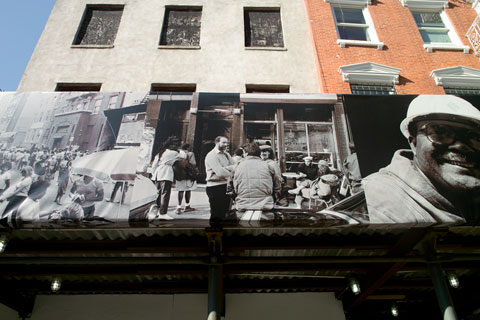
Harsley photos with Dawoud Bey and Wilbert Tatum
© Brian Rose
In the center is a photo of block festival and then comes an image of people congregating in front of Alex’s gallery–the noted photographer Dawoud Bey sits at a round table next to Shirley Campbell, a local resident. And on the end, is a portrait of the late Wilbert Tatum, who lived around the block and was the editor and publisher of the Amsterdam News, one of the nation’s oldest continuously published black newspapers.
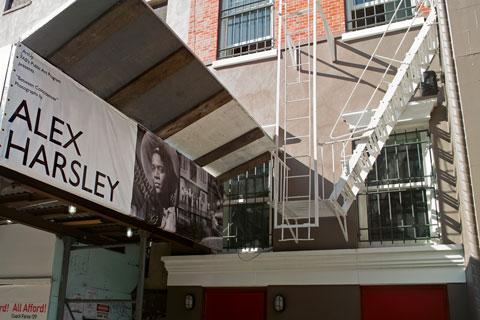
Alex Harsley exhibition with portrait of Jean-Michel Basquiat
© Brian Rose
Around the corner of the scaffolding to the right of “Alex Harsley,” is a portrait of Jean-Michel Basquiat, lounging before a wall on 4th Street, one of the many artists who have inhabited this area of Manhattan. To the right of that is a street scene, kids playing in the spray of an open fire hydrant. It’s a brief, but vivid encapsulation of life and history on this most extraordinary of New York’s blocks.
Alex is now 72 years old, a highly competitive bicycle racer, so I expect he’ll be around for a good while. I love the sidewalk shed, but I’m sore from craning my neck to see the pictures. Will someone please give this guy a major retrospective?
Update:
Meanwhile…from the Times, a lengthy profile of 27 year old Dash Snow–of the deMenil fortune–found dead in the next block on 4th Street:
They encouraged Mr. Snow to exhibit his collages of newspaper headlines, many of them revealing his obsession with Saddam Hussein, and his photographs of oral sex, nude girls, lines of cocaine being snorted off body parts. It worked: His first solo show was in 2005, and his work was included in the 2006 Whitney Biennial.
The art world was not yet settled on whether Mr. Snow was an important artist, a young talent with promise or a reckless pretender. Well-known collectors including Charles Saatchi have bought his pieces, generally at five-figure prices; Benjamin Godsill, a curatorial associate at the New Museum, said Mr. Snow’s work “captures this period bracketed by the fall of the World Trade Center and the fall of the financial system.”
Jacob Lewis, the director of Pace Prints Chelsea, said, “Some people think of him as the Kurt Cobain of the art world. Other people think of him as the Paris Hilton.”
Anyone interested in discovering a serious and important American artist can simply look a few doors down from the Lafayette Hotel and find Alex Harsley.
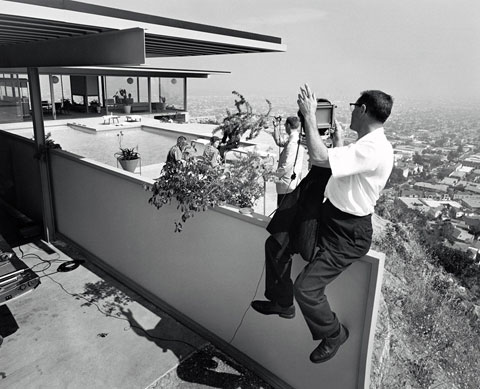
Julius Shulman photographing Case Study house #22 by Pierre Koenig
One of the pioneers in the field of architectural photography, Julius Shulman has died at 98. There are many things that make his work significant–enough for a lengthy essay–but for me, it was the idea of architectural photography as a staged event. The end result being a near seamless transformation of reality in which the building or interior is held in perfect equipoise.
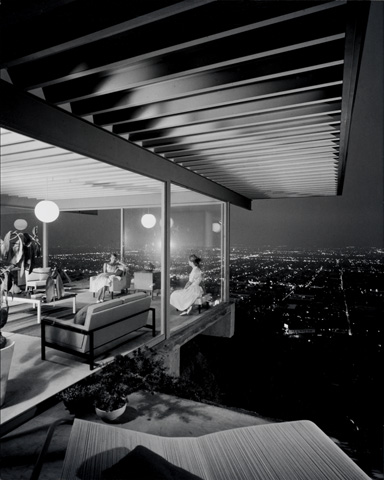
Photograph by Julius Shulman
I only own a few photographs–alas, I wish I could afford more–and one of those is the famous night time view of Case Study house #22 by Shulman in which two women in diaphanous gowns lounge in the glass living room floating out above the carpet of lights of Los Angeles.
A couple of months ago I put up some pictures of pickup basketball made with my digital camera–experimenting with the idea of of photographing in between moments of the game–for instance, when the ball is on the rim, and the players are jockeying for position or blocking out for a rebound.
Rather than work with a fast nimble camera, I’m working with the 4×5 view camera, exploiting, in a sense, its awkwardness for the task–waiting for moments of relative stillness, players gazing upward, or poised for a play developing out of the frame. The 4×5 negatives can be scanned at high resolution and printed at large scale.
I’ve played basketball most of my life, and know the street game well. There is a gritty poetry to the way it’s played in the city, the ex-college players, faded high school stars, and playground wannabes all jostling for the ball, struggling for fleeting moments of glory or the satisfaction of fitting in, keeping up, playing within oneself.
Quality of play on the Lower East Side is mixed, but I’ve seen some really good players lately in Roosevelt Park just south of Houston Street. It’s a diverse group of all ethnicities, all shapes and sizes, decked out in equally varied clothing and foot gear.
Click on the photos to get at least some sense of the detail of the 4×5 film.
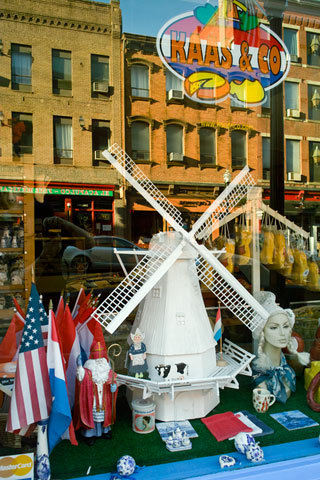
A Taste of Holland, South Norwalk, Connecticut
© Brian Rose
Killing some time waiting for the train back to New York, we discovered the shop pictured above, which specializes in all things Dutch, especially food items like licorice (drop) and cheese (kaas). It also flogs the usual Dutch cliches such as windmills, wooden shoes, Delft Blue, and Sinter Klaas–all seen against a reflected backdrop of South Norwalk’s Washington Street.
They’re on the web. Mmm. Might have to order some Borrelnootjes and Stroopwaffels.